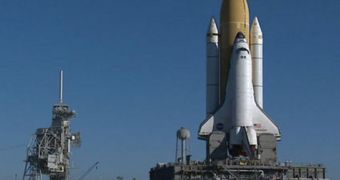Yesterday, mission controllers at the NASA Kennedy Space Center (KSC), in Cape Canaveral, Florida, moved the space shuttle Endeavor to its launch pad. Under freezing conditions, the spacecraft was placed atop the Crawler Transporter vehicle, the second largest tracked machine in the world, and carried to Launch Pad 39A, the only facility in the world that is still equipped to launch space shuttles. The craft is scheduled to take off for the International Space Station (ISS) in February, when it will deliver a new module, and an adjacent component, as well as spare parts and supplies, Space reports.
Endeavor will carry out the first of the last five planned shuttle flights ever, as the fleet is scheduled to be retired by this September. It will deliver the Node 3, named Tranquility, to the ISS, which is the last major contribution to the station. The module will also be outfitted with the Cupola, a seven-windowed dome that will facilitate robotic-arm operations on the space station. Together, the two components will considerably increase the capabilities of the ISS, and will also provide more room for the permanent, six-member crew currently aboard the orbital facility.
Mission planners say that Endeavor will most likely launch at 4:39 am EST (0939 GMT) on Sunday, February 7, and that this will most likely be the last night launch for a space shuttle. NASA regulations state that the spacecraft cannot launch in freezing conditions, when it's less than two degrees Celsius (32 degrees Fahrenheit) outside. The cold weather front that hit the KSC yesterday was, however, insufficient to trigger a cancellation of the rollout procedure. “We're not really worried so much about the hardware, we're worried about the software – the people. Nobody will be outside along the way for more than a half hour,” Allard Beutel, a NASA spokesman, said.
“Certain parts of the orbiter have to be kept warm at a certain temperature, but that's part of our standard operations anyway,” he added. The trek, which began at 4:13 am EST (0913 GMT), saw none of the dozens of engineers accompanying the Crawler Transporter and Endeavor outside for more than 30 minutes, The auxiliary personnel rotated in and out of the accommodations aboard the Apollo-era machine, so as to prevent any incidents caused by the excessive cold. The 5.4-kilometer (3.4-mile) journey, from the Vehicle Assembly Building (VAB) to Launch Pad 39A, took about six hours to complete.

 14 DAY TRIAL //
14 DAY TRIAL //